Evaluation of the Potential of Sasobit REDUX Additive to Lower Warm-Mix Asphalt Production Temperature
Abstract
1. Introduction
2. Methodology and Materials
3. Specimen Preparation and Tests
3.1. Specimen Preparation
3.2. Volumetric Properties
3.3. Marshall Test
3.4. Compactability Test
4. Results and Discussion
4.1. Volumetric Properties
4.2. Marshall Test
4.3. Compactability Test
5. Conclusions
- Although the WMA-Marshall properties were inferior to the HMA ones, the Marshall properties of the Sasobit REDUX-WMA fulfilled the specifications and they were then globally satisfactory.
- The Sasobit REDUX-Marshall stability was higher than the Sasobit one.
- The compactability of the Sasobit REDUX-WMA produced at lower production temperatures was better than the achieved with the HMA.
- The compactability of the Sasobit REDUX-WMA compacted at 90 °C is equal to the one compacted at 110 °C. Therefore, the compaction temperature of the Sasobit REDUX-WMA has the potential to be reduced by 20 °C. Such a reduction in production temperatures would have important environmental benefits. Besides energy cost reduction, this technology leads to a decrease in the emissions of gases and odors from asphalt plants, and an improvement in the personal working conditions.
Author Contributions
Funding
Acknowledgments
Conflicts of Interest
References
- Capitão, S.D.; Picado-Santos, L.G.; Martinho, F. Pavement engineering materials: Review on the use of warm-mix asphalt. Constr. Build. Mater. 2012, 36, 1016–1024. [Google Scholar] [CrossRef]
- Hassan, M. Evaluation of the environmental and economic impacts of warm-mix asphalt using life-cycle assessment. Int. J. Constr. Educ. Res. 2010, 6, 238–250. [Google Scholar] [CrossRef]
- Mallick, R.B.; Bergendahl, J. A laboratory study on CO2 emission from asphalt binder and its reduction with the use of warm mix asphalt. Int. J. Sustain. Eng. 2009, 2, 275–283. [Google Scholar] [CrossRef]
- Rubio, M.C.; Martínez, G.; Baena, L.; Moreno, F. Warm mix asphalt: An overview. J. Clean. Prod. 2012, 24, 76–84. [Google Scholar] [CrossRef]
- Kheradmand, B.; Muniandy, R.; Hua, L.T.; Yunus, R.B.; Solouki, A. An overview of the emerging warm mix asphalt technology. Int. J. Pavement Eng. 2014, 15, 79–94. [Google Scholar] [CrossRef]
- Xu, S.; Xiao, F.; Amirkhanian, S.; Singh, D. Moisture characteristics of mixtures with warm mix asphalt technologies—A review. Constr. Build. Materi. 2017, 142, 148–161. [Google Scholar] [CrossRef]
- Mohd Hasan, M.R.; You, Z.; Yang, X. A comprehensive review of theory, development, and implementation of warm mix asphalt using foaming techniques. Constr. Build. Mater. 2017, 152, 115–133. [Google Scholar] [CrossRef]
- Edwards, Y.; Isacsson, U. Wax in bitumen (Part II—Characterization and Effects). Road Mater. Pavement Des. 2005, 6, 439–468. [Google Scholar] [CrossRef]
- Kataware Aniket, V.; Singh, D. Effects of wax-based, chemical-based, and water-based warm-mix additives on mechanical performance of asphalt binders. J. Mater. Civ. Eng. 2018, 30, 04018237. [Google Scholar] [CrossRef]
- EAPA. Asphalt in Figures 2017; European Asphalt Pavement Association: Brussels, Belgium, 2018. [Google Scholar]
- Woszuk, A. Application of fly ash derived zeolites in warm-mix asphalt technology. Materials 2018, 11, 1542. [Google Scholar] [CrossRef]
- Liu, K.; Zhang, K.; Wu, J.; Muhunthan, B.; Shi, X. Evaluation of mechanical performance and modification mechanism of asphalt modified with graphene oxide and warm mix additives. J. Clean. Prod. 2018, 193, 87–96. [Google Scholar] [CrossRef]
- Sasol. Sasobit and Sasobit Redux products. Available online: https://www.sasobit.com/ (accessed on 11 March 2019).
- Edwards, Y.; Isacsson, U. Wax in Bitumen (Part I—Classifications and General Aspects). Road Mater. Pavement Des. 2005, 6, 281–309. [Google Scholar] [CrossRef]
- Lu, X.; Redelius, P. Effect of bitumen wax on asphalt mixture performance. Constr. Build. Mater. 2007, 21, 1961–1970. [Google Scholar] [CrossRef]
- Fazaeli, H.; Behbahani, H.; Amini, A.A.; Rahmani, J.; Yadollahi, G. High and Low Temperature properties of ft-paraffin-modified bitumen. Adv. Mater. Sci. Eng. 2012, 2012, 7. [Google Scholar] [CrossRef]
- Wu, S.; Wen, H.; Zhang, W.; Shen, S.; Mohammad, L.N.; Faheem, A.; Muhunthan, B. Field performance of top-down fatigue cracking for warm mix asphalt pavements. Int. J. Pavement Eng. 2019, 20, 33–43. [Google Scholar] [CrossRef]
- Chen, S.; You, Z.; Sharifi, N.P.; Yao, H.; Gong, F. Material selections in asphalt pavement for wet-freeze climate zones: A review. Constr. Build. Mater. 2019, 201, 510–525. [Google Scholar] [CrossRef]
- Jamshidi, A.; Hamzah, M.O.; You, Z. Performance of warm mix asphalt containing sasobit®: State-of-the-art. Constr. Build. Mater. 2013, 38, 530–553. [Google Scholar] [CrossRef]
- Yu, H.; Leng, Z.; Dong, Z.; Tan, Z.; Guo, F.; Yan, J. Workability and mechanical property characterization of asphalt rubber mixtures modified with various warm mix asphalt additives. Constr. Build. Mater. 2018, 175, 392–401. [Google Scholar] [CrossRef]
- Sanchez-Alonso, E.; Vega-Zamanillo, A.; Castro-Fresno, D.; DelRio-Prat, M. Evaluation of compactability and mechanical properties of bituminous mixes with warm additives. Constr. Build. Mater. 2011, 25, 2304–2311. [Google Scholar] [CrossRef]
- Mo, L.; Li, X.; Fang, X.; Huurman, M.; Wu, S. Laboratory investigation of compaction characteristics and performance of warm mix asphalt containing chemical additives. Constr. Build. Mater. 2012, 37, 239–247. [Google Scholar] [CrossRef]
- Oliveira, J.R.M.; Silva, H.M.R.D.; Abreu, L.P.F.; Fernandes, S.R.M. Use of a warm mix asphalt additive to reduce the production temperatures and to improve the performance of asphalt rubber mixtures. J. Clean. Prod. 2013, 41, 15–22. [Google Scholar] [CrossRef]
- Pérez-Jiménez, F.; Martínez, A.H.; Miró, R.; Hernández-Barrera, D.; Araya-Zamorano, L. Effect of compaction temperature and procedure on the design of asphalt mixtures using Marshall and gyratory compactors. Constr. Build. Mater. 2014, 65, 264–269. [Google Scholar] [CrossRef]
- Infraestruturas de Portugal. Caderno de Encargos Tipo Obra; Infraestruturas de Portugal: Almada, Portugal, 2014. [Google Scholar]
- Martinho, F.C.G.; Picado-Santos, L.G.; Capitão, S.D. Mechanical properties of warm-mix asphalt concrete containing different additives and recycled asphalt as constituents applied in real production conditions. Constr. Build. Mater. 2017, 131, 78–89. [Google Scholar] [CrossRef]
- CEN. EN 12697-30, Bituminous Mixtures—Test Methods For Hot Mix Asphalt—Part 30: Specimen Preparation By Impact Compactor; European Committee For Standardization: Brussels, Belgium, 2012. [Google Scholar]
- CEN. EN 12697-31, Bituminous Mixtures—Test Methods For Hot Mix Asphalt—Part 31: Specimen Preparation By Gyratory Compactor; European Committee For Standardization: Brussels, Belgium, 2007. [Google Scholar]
- O’Flaherty, C.A. HIGHWAYS—The Location, Design, Construction and Maintenance of Road Pavements, 4th ed.; Butterworth-Heinemann: Oxford, UK, 2002. [Google Scholar]
- CEN. EN 12697-6, Bituminous Mixtures—Test Methods for Hot Mix Asphalt—Part 6: Determination of bulk density of bituminous specimens; European Committee For Standardization: Brussels, Belgium, 2012. [Google Scholar]
- CEN. EN 12697-5, Bituminous Mixtures—Test methods for hot mix asphalt—Part 5: Determination of the maximum density; European Committee For Standardization: Brussels, Belgium, 2018. [Google Scholar]
- CEN. EN 12698-8, Bituminous Mixtures—Test methods—Part 8: Determination of void characteristics of bituminous specimens; European Committee For Standardization: Brussels, Belgium, 2018. [Google Scholar]
- Pereira, P.; Pais, J. Main flexible pavement and mix design methods in Europe and challenges for the development of an European method. J. Traffic Trans. Eng. 2017, 4, 316–346. [Google Scholar] [CrossRef]
- Lavin, P. Asphalt Pavements—A Practical Guide to Design, Production and Maintenance for Engineers and Architects; CRC Press: London, UK, 2003. [Google Scholar]
- Masoudi, S.; Abtahi, S.M.; Goli, A. Evaluation of electric arc furnace steel slag coarse aggregate in warm mix asphalt subjected to long-term aging. Constr. Build. Mater. 2017, 135, 260–266. [Google Scholar] [CrossRef]
- Tušar, M.; Šlibar, M.; Ipavec, A.; Turk, M.R. Study of compactability models describing asphalt specimen compaction with gyratory and with impact compactor. In Proceedings of the CETRA—4th International Conference on Road and Rail Infrastructure, Šibenik, Croatia, 23–25 May 2016. [Google Scholar]
- Topini, D.; Toraldo, E.; Andena, L.; Mariani, E. Use of recycled fillers in bituminous mixtures for road pavements. Constr. Build. Mater. 2018, 159, 189–197. [Google Scholar] [CrossRef]
- Gardete, D.; Picado-Santos, L.; Capitão, S. Avaliação da trabalhabilidade de misturas betuminosas com base nas curvas de compactação (Evaluation of the workability of asphalt mixtures using compaction curves). In Proceedings of the 8º Congresso Rodoviário Português (8th Portuguese Road Conference), Lisbon, Portugal, 12–14 April 2016. [Google Scholar]
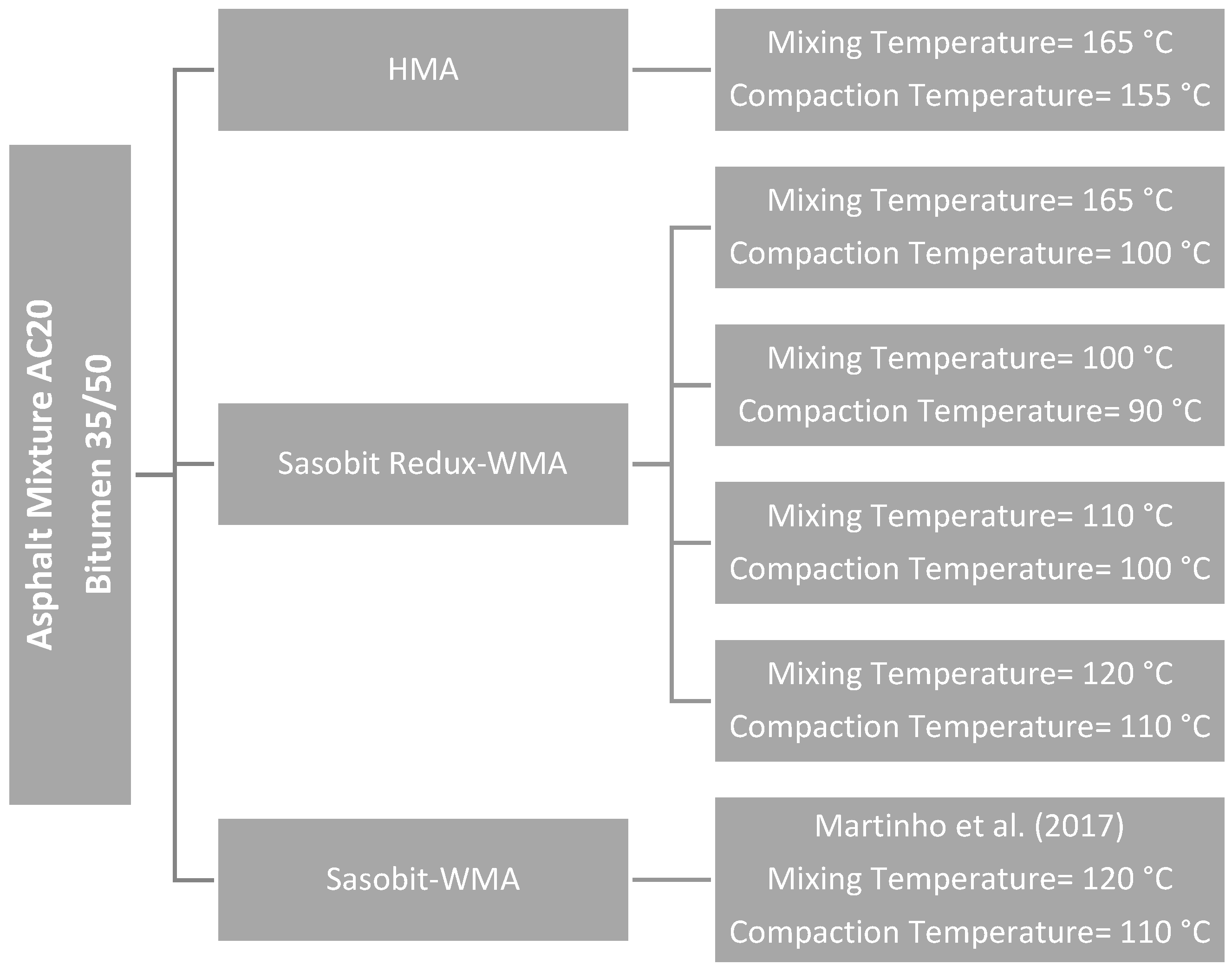
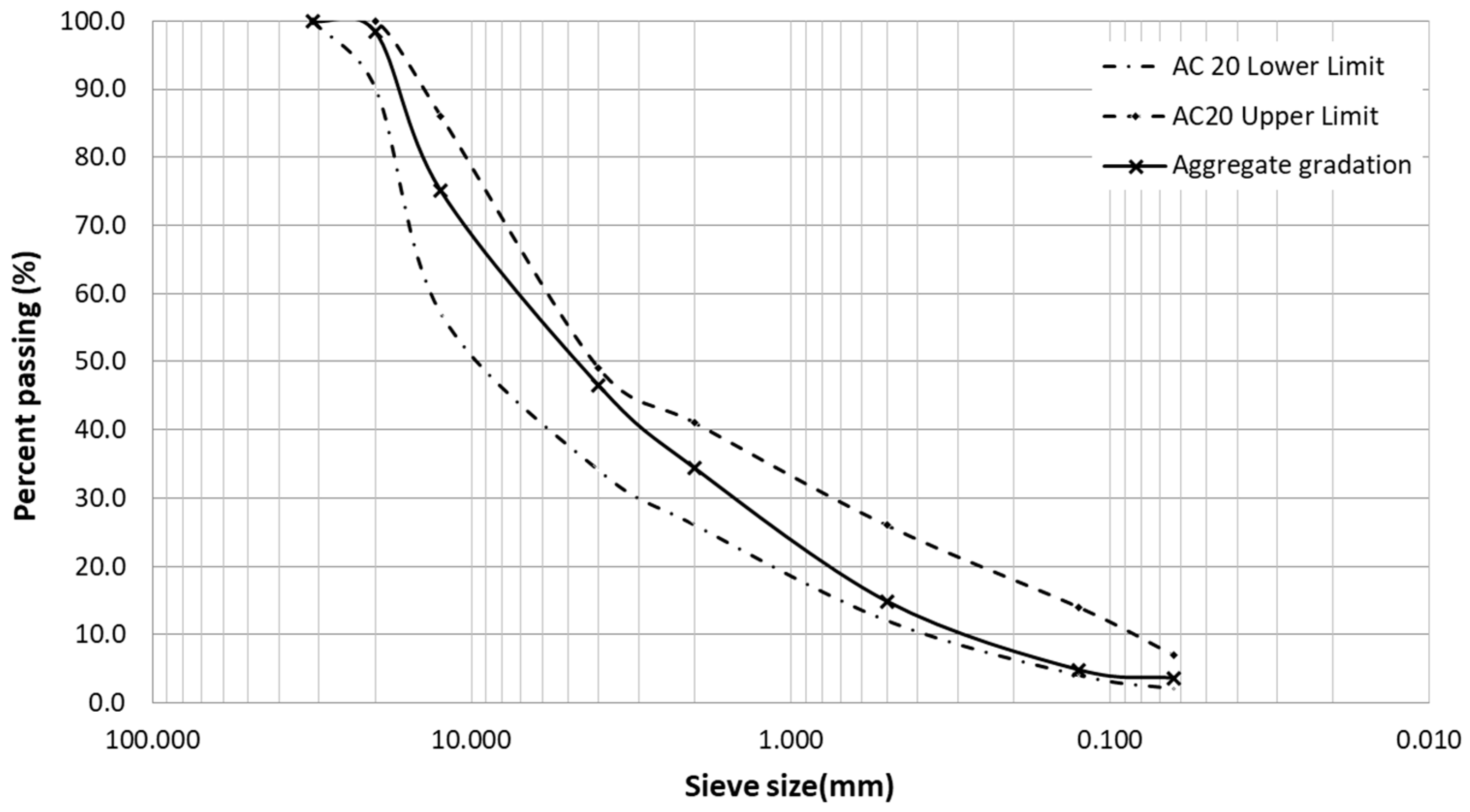
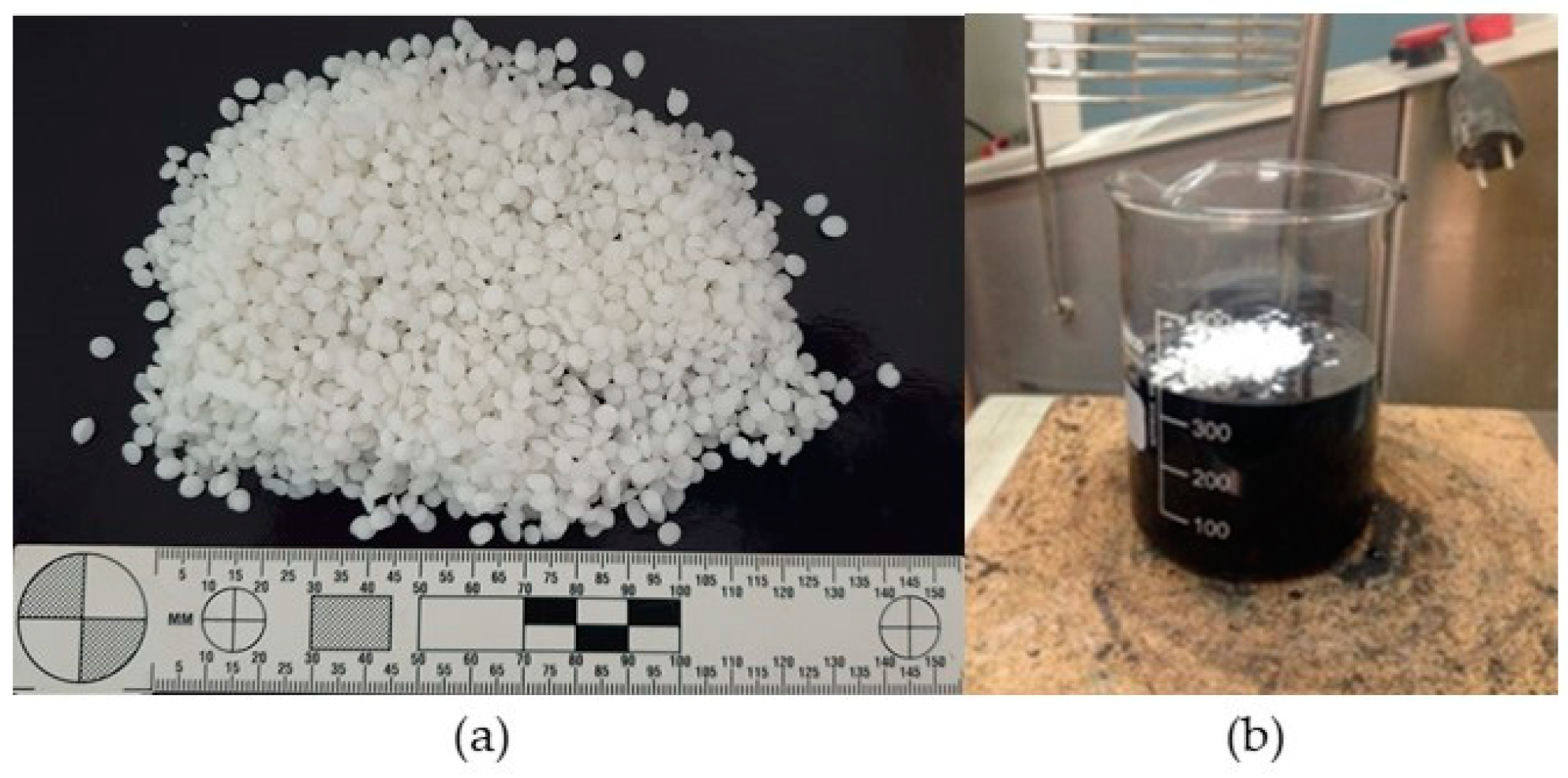
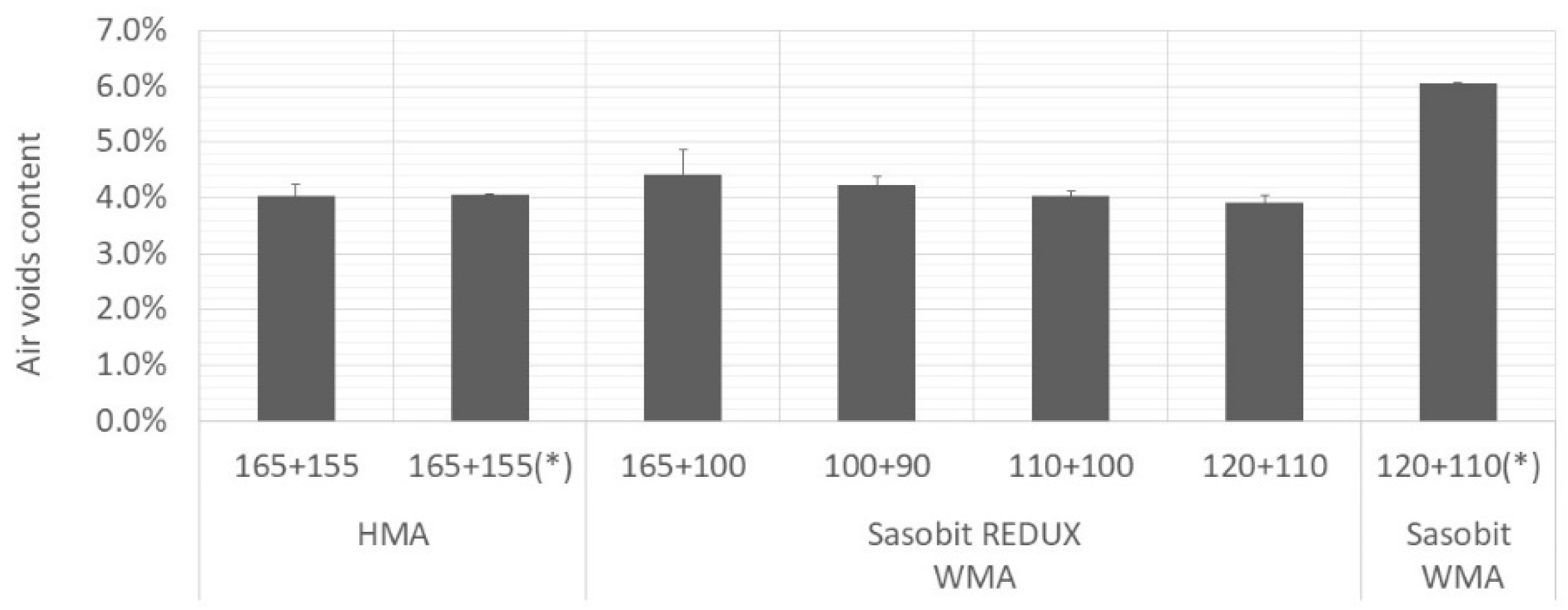
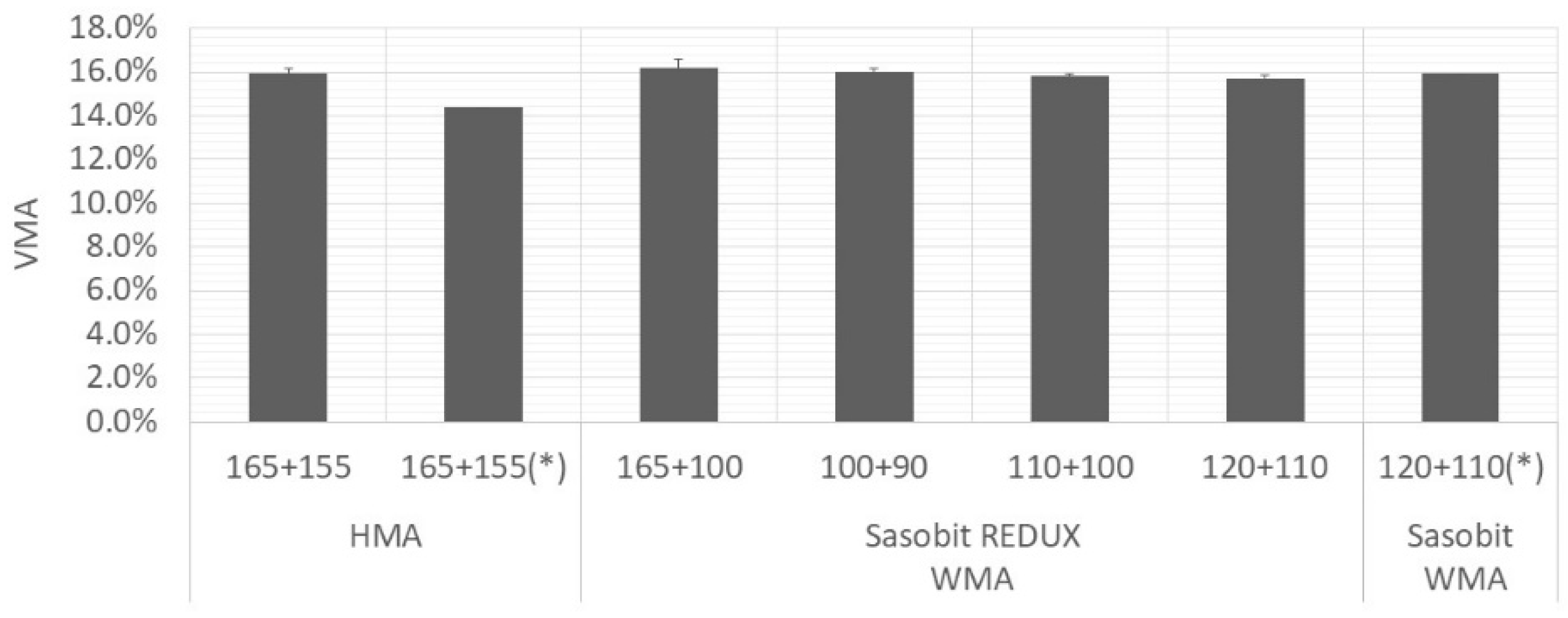
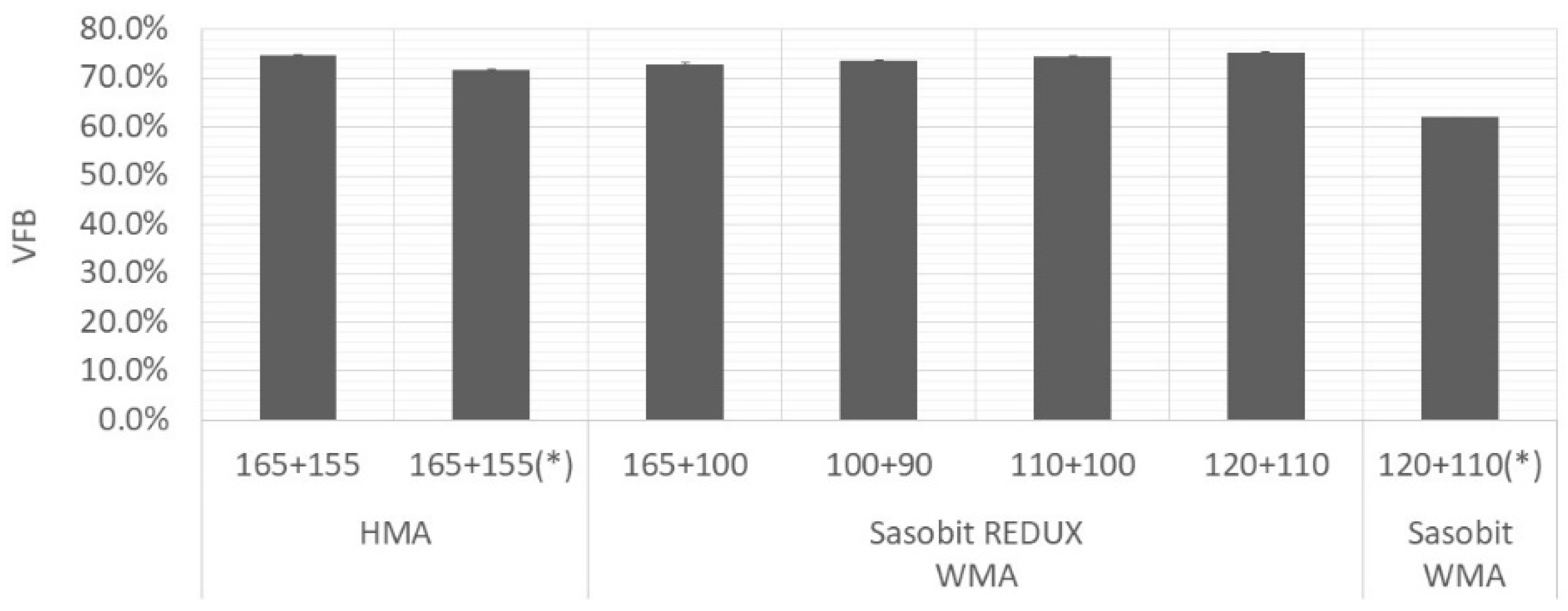
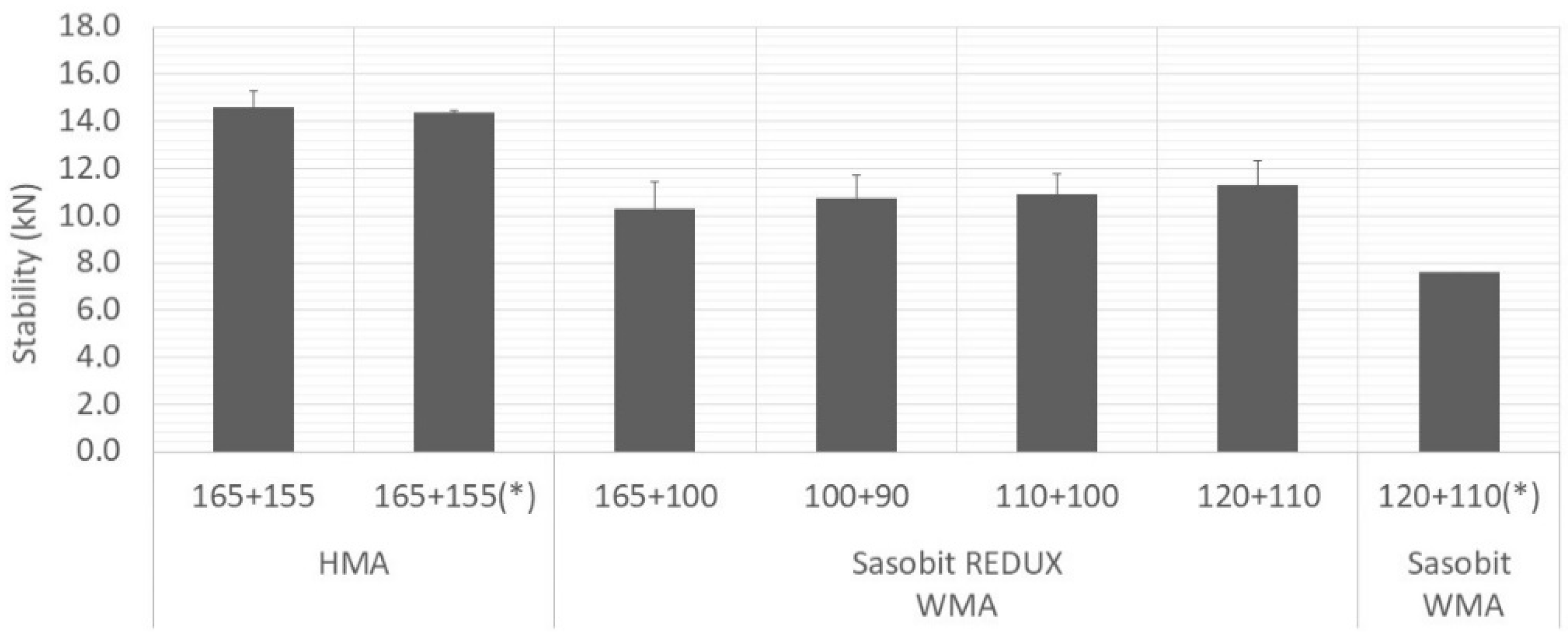
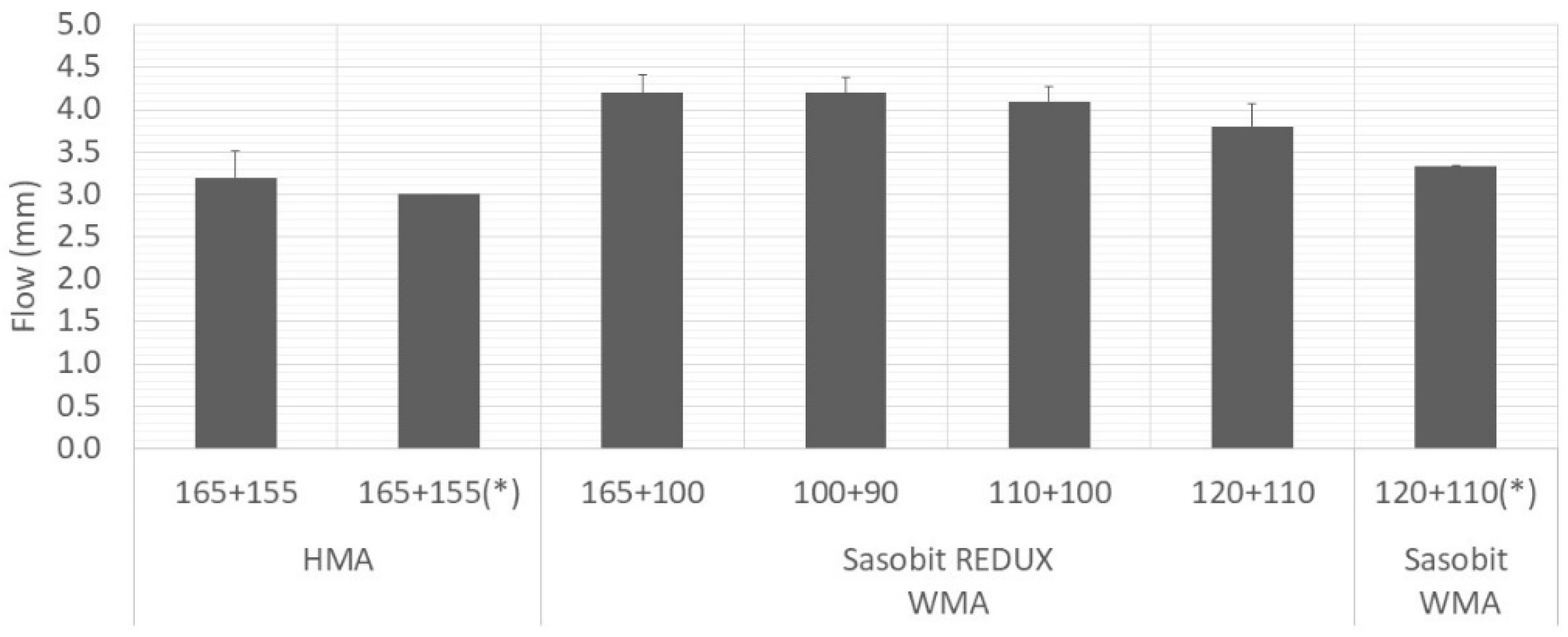
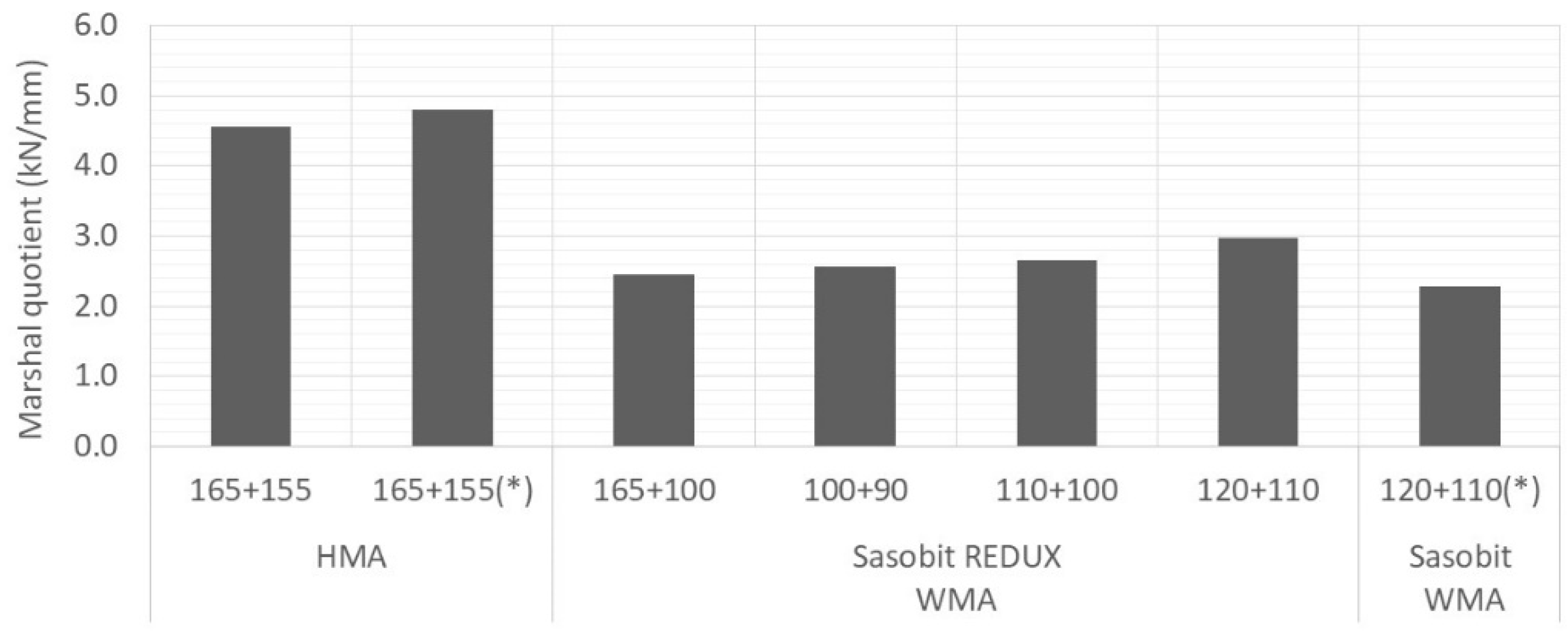
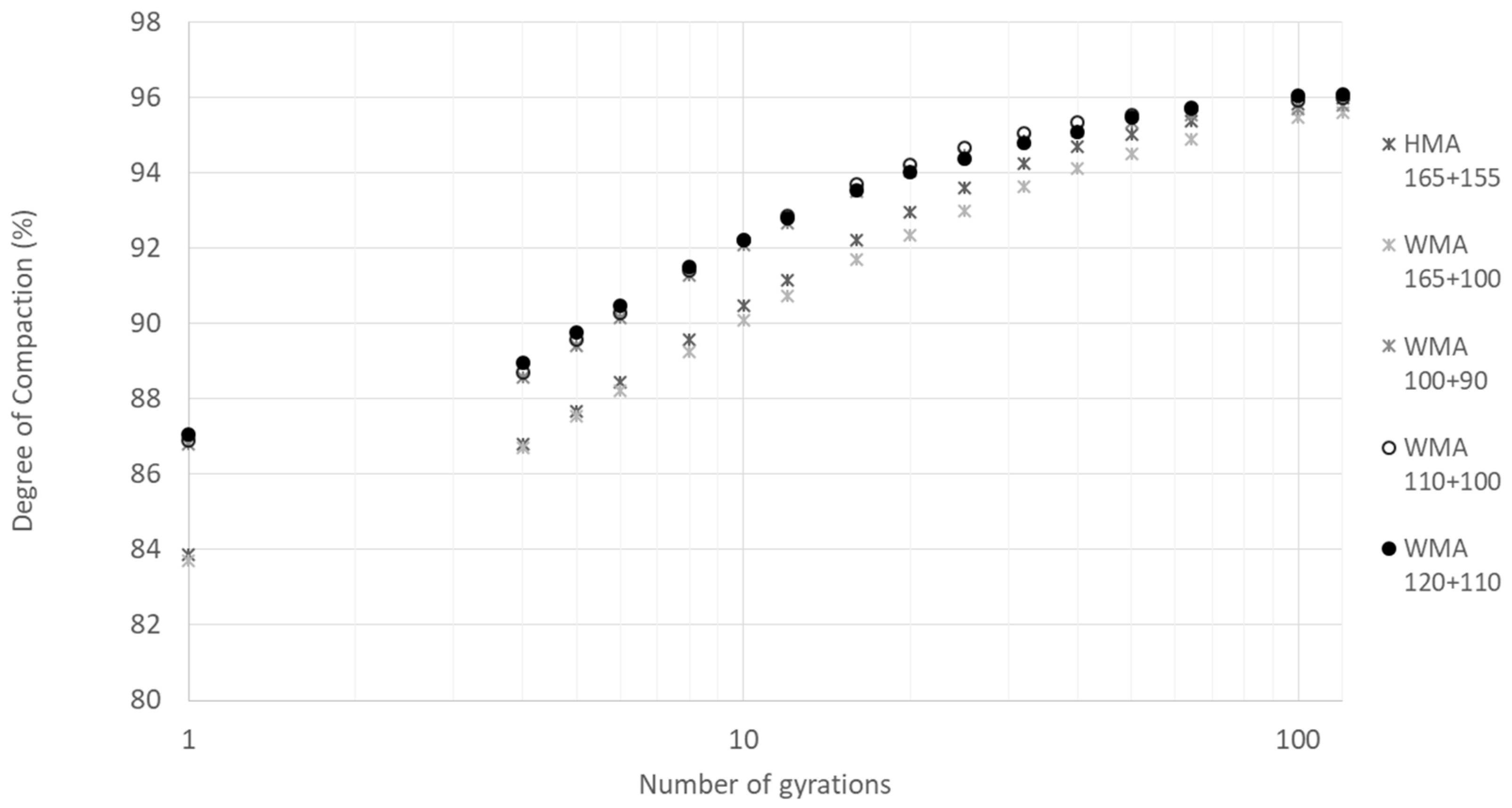
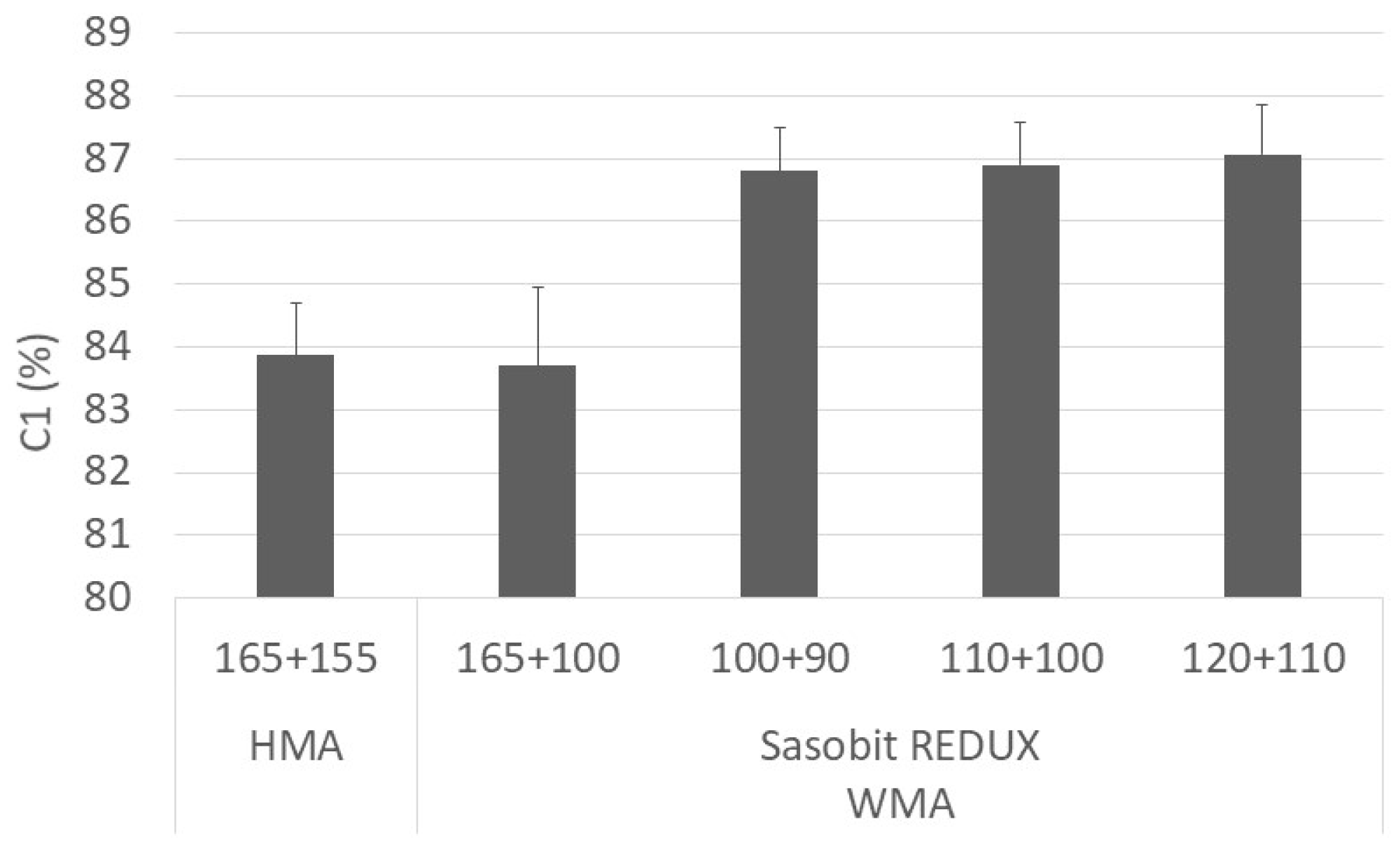

| Parameter | Sasobit REDUX | Sasobit |
|---|---|---|
| Melting point (°C) | 72–83 | 100–110 |
| Penetration (25 °C)—0.1 mm | 16–30 | 0–20 |
© 2019 by the authors. Licensee MDPI, Basel, Switzerland. This article is an open access article distributed under the terms and conditions of the Creative Commons Attribution (CC BY) license (http://creativecommons.org/licenses/by/4.0/).
Share and Cite
Almeida, A.; Sergio, M. Evaluation of the Potential of Sasobit REDUX Additive to Lower Warm-Mix Asphalt Production Temperature. Materials 2019, 12, 1285. https://doi.org/10.3390/ma12081285
Almeida A, Sergio M. Evaluation of the Potential of Sasobit REDUX Additive to Lower Warm-Mix Asphalt Production Temperature. Materials. 2019; 12(8):1285. https://doi.org/10.3390/ma12081285
Chicago/Turabian StyleAlmeida, Arminda, and Michela Sergio. 2019. "Evaluation of the Potential of Sasobit REDUX Additive to Lower Warm-Mix Asphalt Production Temperature" Materials 12, no. 8: 1285. https://doi.org/10.3390/ma12081285
APA StyleAlmeida, A., & Sergio, M. (2019). Evaluation of the Potential of Sasobit REDUX Additive to Lower Warm-Mix Asphalt Production Temperature. Materials, 12(8), 1285. https://doi.org/10.3390/ma12081285






